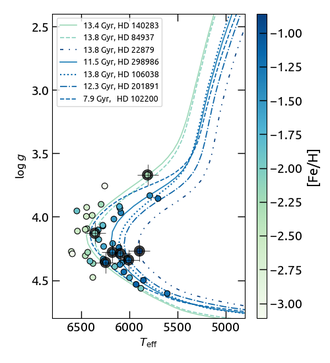
Astronomers at the Nicolaus Copernicus Astronomical Centre (CAMK) have determined the surface temperature and gravity of 48 old, metal-poor stars with an accuracy of 1%. These 48 stars have chemical elements in amounts that are 10 to 1000 times less than what is found in the Sun. They are also old, the majority was formed 10 to 13 Gyr ago. These ancient stars hold clues to the processes of formation and early evolution of our Galaxy. The research was lead by Riano E. Giribaldi, post-doc at CAMK, and counts with the collaboration of André Rodrigo da Silva and Rodolfo Smiljanic.
The determination of surface temperature and gravity is the first step needed to calculate the stellar chemical composition. With these
parameters and the chemical composition, astronomers can test models of the internal physics of stars and learn about the chemical enrichment history of the Milky Way.
However, determining correct values of the atmospheric parameters with high accuracy is very challenging. The most direct method to calculate the surface temperature of a star involves measuring the observed energy flux in a wide wavelength range and the stellar diameter with interferometry. Unfortunately, interferometric measurements are restricted to a small number of bright, relatively nearby stars.
Old, metal-poor stars, which belong to the Milky Way halo, are mostly dim and located far from the Sun. Not more than 10 of these stars have diameters measured with interferometry. The alternative for these stars is the use of indirect methods based on photometry or spectroscopy that are usually more affected by systematic modelling errors.
The team at CAMK has developed a method to estimate accurate parameters from high-quality stellar spectra that overcomes some of the common difficulties. The novel aspects include an improved spectral-fitting procedure, and the combination of state-of-the-art models of the strong H-alpha Balmer absorption line of hydrogen with precise parallaxes obtained by the Gaia mission of the European Space Agency. With this method, it has been possible to obtain surface temperatures and gravities that are accurate to 1%.
This sample of stars with accurate parameters has been called the Titans. In Greek mythology, the Titans are the offspring of Gaia. The
atmospheric parameters in this sample owe their fine accuracy to the Gaia mission. That is the reason why the team has decided to call these stars Titans.
This research was funded by an OPUS grant from NCN.
The article, "Titans metal-poor reference stars. I. Accurate effective temperatures and surface gravities for dwarfs and subgiants from 3D non-LTE Hα profiles and Gaia parallaxes", was recently accepted for publication in the journal Astronomy & Astrophysics and is available in the arXiv.
Figure caption: Distribution of the Titans in a plot of the logarithm of the surface gravity (log g) as a function of the effective temperature
(Teff). The tracks are models that show the position of stars of a given age and chemical composition in different stages of evolution. The Titans are all main sequence and subgiant stars.
Text: Rodolfo Smiljanic






